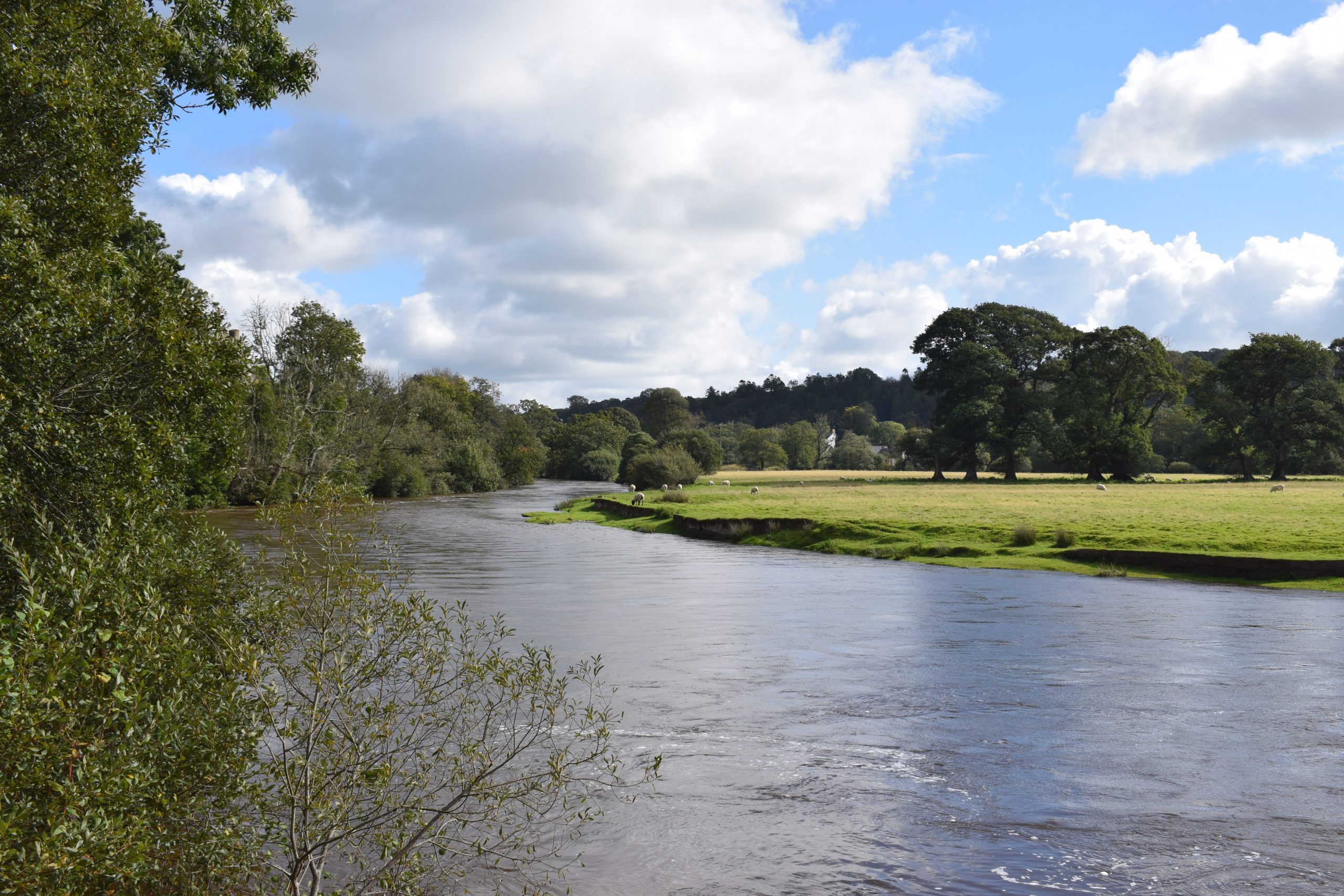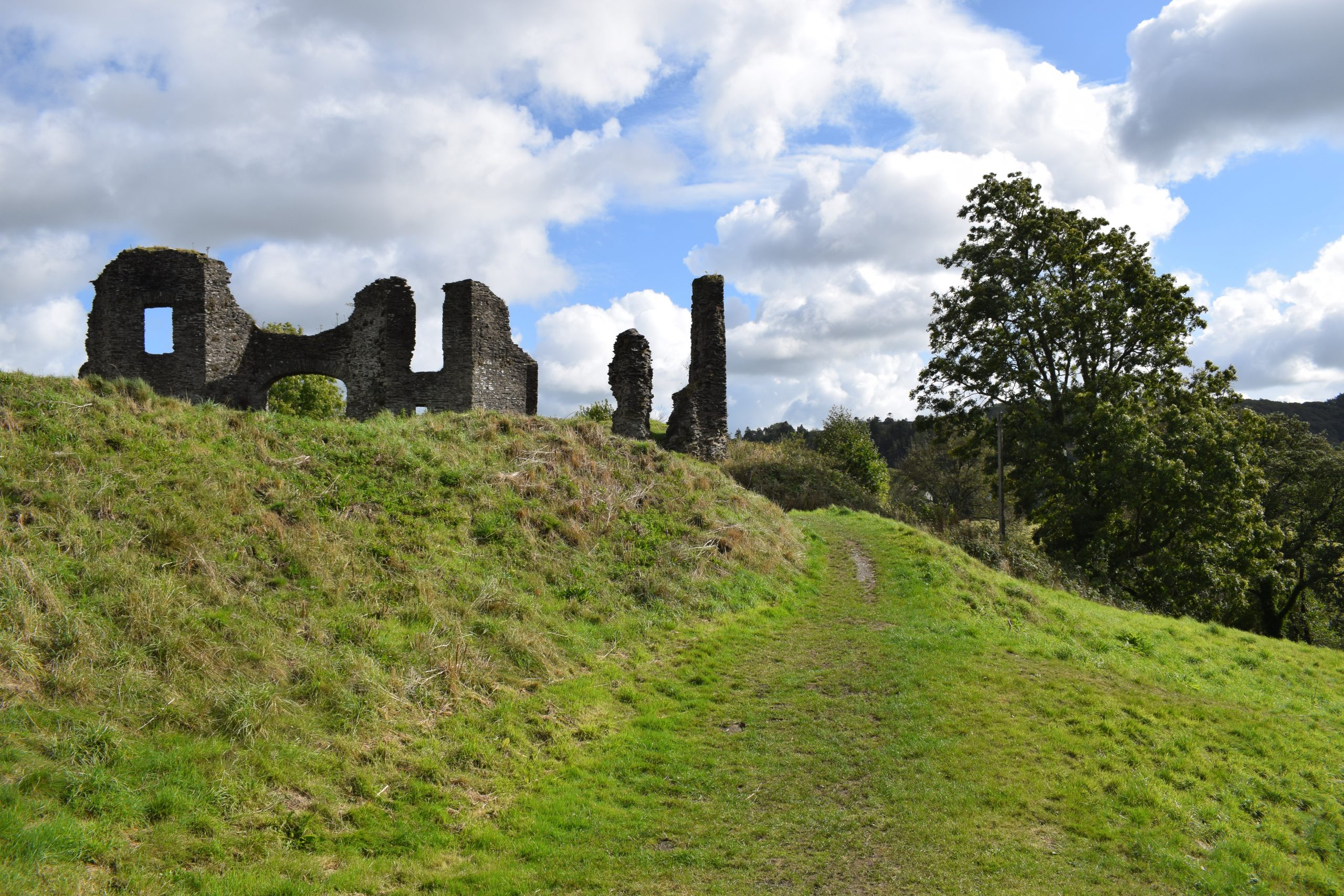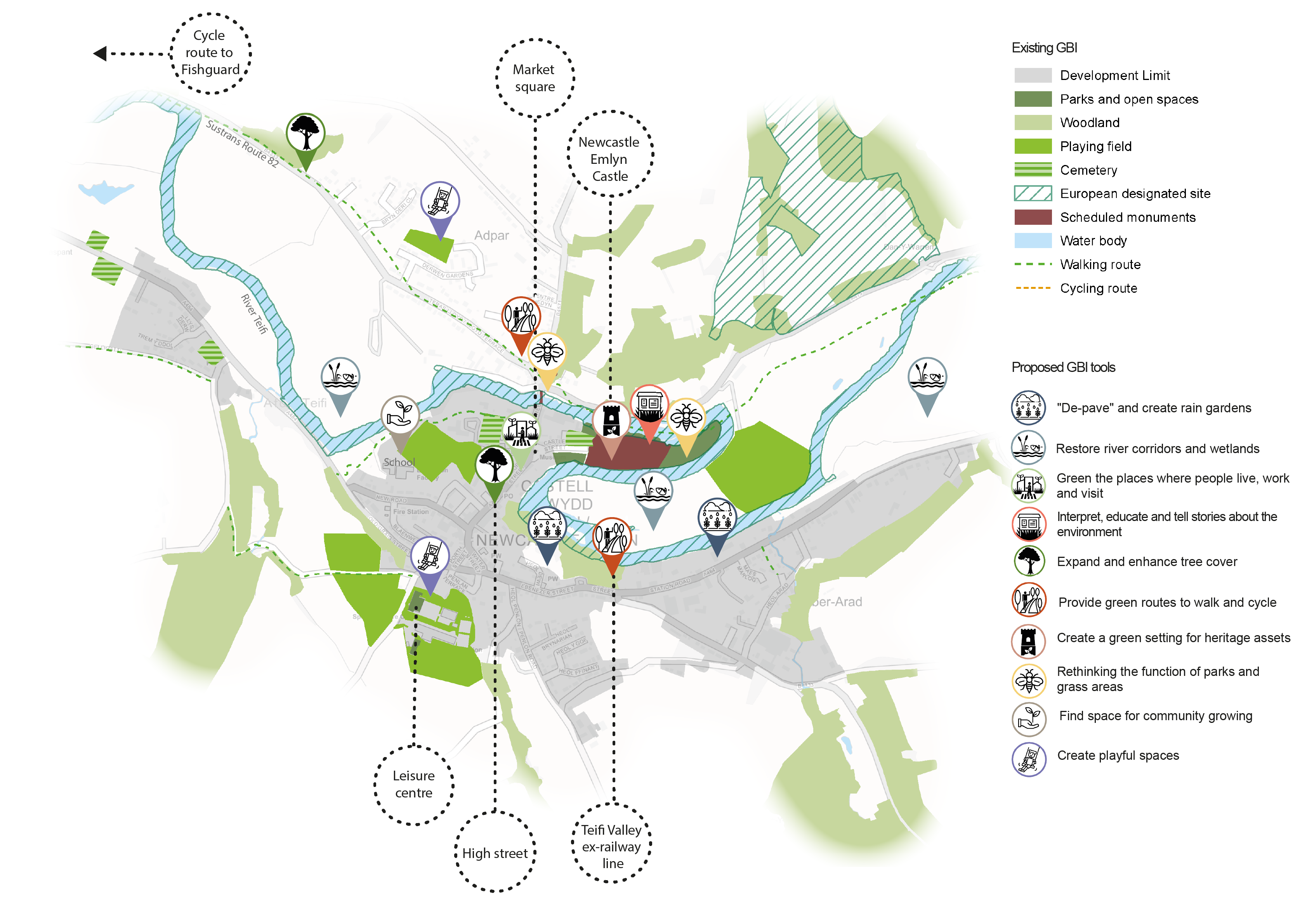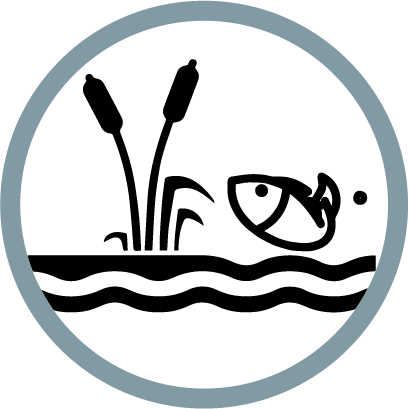Newcastle Emlyn Action Plan
A green-blue portrait of Newcastle Emlyn
Image: View of river corridor from bridge in Newcastle Emlyn

The River Teifi river runs through the small market town of Newcastle Emlyn, with rolling hills on either side. The town is identified by the Future Wales national plan as a Regional Growth Area in Mid Wales. The Sustrans National Cycle Route 82 passes through the town and connects with Fishguard, the gateway to the Pembrokeshire National Park.
The river is a prominent feature in the town and provides an important setting for it along a key blue corridor. The town itself sits mostly on a promontory of higher ground, with some development on the floodplain either side of the river.
The river also forms the basis of local attractions and recreation opportunities. These include sport fishing, kayaking and walking on riverside paths.
The historic ruins of Newcastle Emlyn Castle overlook the river and a cluster of heritage assets and independent shops can be found in the town. However, despite Newcastle Emlyn’s riverside location and setting, in places the town centre lacks a strong connection to the river and surrounding natural environment.
Image: River floodplain within Newcastle Emlyn

Image: green setting for the castle in Newcastle Emlyn

“The river is prone to severe flooding but there is massive potential to do something here such as introducing beavers, harnessing the power from the river…”
– Stakeholder, online survey
See Appendix A for a summary of all stakeholder comments.
What are the key challenges facing Newcastle Emlyn?
Flooding
The majority of the town lies outside the floodplain. However, some properties are still at risk on either side of the river. There are large impermeable areas including car parks on Tanyard Lane and New Road, the cattle market site and Ysgol y Ddwylan. This risk is expected to be exacerbated by climate change.
Economy and public realm
Newcastle Emlyn is a traditional market town which serves the River Teifi area and community in both Carmarthenshire and Ceredigion. The town supports several large regional agricultural employers and local services including food producers and tourism businesses.
The historic town centre is vibrantly painted and attractive. However, the economy experiences less tourism trade than nearby coastal towns and has been threatened by the long-term effects of Covid-19 and wider trends. Vacant retail properties comprised 10% of the town centre in 2021. Despite the general vibrancy of the centre, some vacant and poorly maintained spaces are missed opportunities to support the growth of the tourism industry.
Population
As elsewhere, the GBI network will need to respond to the needs of the ageing population in Newcastle Emlyn. Household incomes and economic activity are below the average for Wales for most areas of the town. Improved access to high quality green space across the town would provide an important well-being resource.
Welsh language
Consultees reported little visual use of Welsh and Welsh speaking staff in the town, or Welsh speakers establishing their own businesses in Newcastle Emlyn. However, Welsh speaking in Newcastle Emlyn remains above the average for both Carmarthenshire and Wales.
Access to green space
Carmarthenshire’s Open Space Assessment (2020) highlights relatively low provision and access to natural green space and open space in Newcastle Emlyn. However, it highlights a deficit in provision for children and young people.
Map of key opportunities in Newcastle Emlyn

View the full GBI toolbox, learn how to use the toolbox with each town and explore the map of green and blue infrastructure assets in Carmarthenshire in more detail.
Overview of key opportunities for Newcastle Emlyn’s GBI network
The paragraphs below provide further commentary on the GBI opportunities highlighted in the map above.

'Depave' and create rain gardens
Residential areas on either side of the river and key roads such as Bridge Street should be prioritised for protection against river flooding. There are opportunities for depaving or increasing permeability at the extensive car parks, paved and heavily built-up areas in the towns. This would reduce the risk of surface water flooding.
Targeted rain garden projects could be introduced along Sycamore Street and at car parks at Cawdor, Castle and Tanyard Lane. Depaving and SuDS provision should also be an integrated part of significant new developments and neighbourhoods such as those at Tanyard Lane and Station Road.

Restore river corridors and wetlands
Natural Resources Wales identified large areas along the Afon Teifi where planting additional floodplain and riparian woodland would aid Natural Flood Management (NFM). Riparian planting and wetland management would also be an opportunity to enhance carbon storage and habitats.
Improving access to riverside areas for recreation by linking together riverside walkways (with high quality wayfinding and resting points) would create valuable multifunctional GBI linkages. Control of Himalayan Balsam and other invasives may be needed in order to help native flowers flourish. The floodplain to the east of the town offers significant potential for a rich wetland landscape as part of a multifunctional nature-based solution.

Green the places where people live, work and visit
The high street in Newcastle Emlyn has the potential to develop a strong sense of place. A greener high street would encourage both locals and visitors to spend more time in the town.
Reshaping and greening the busy A475 route through the centre of the town could be achieved using appropriate localised environmental enhancements including greener boundary treatments (streets), pedestrian routes, landscaping, pocket parks and green roofs on bus stops. This would create a stronger sense of place and distinctiveness and would create additional outdoor seating for local hospitality businesses to use.

Interpret, educate and tell stories about the environment
Interpretation boards should highlight bird watching opportunities and information on local habitats and species.
Improving the signage around both natural features and historic environment assets like the castle would better tell the story of the landscape. It would also encourage visitors to stay longer and explore the town’s otter, bird and bat habitats.

Expand and enhance tree cover
Key corridors where street trees could be targeted include the National Cycle route connecting the town to Fishguard. The high street would also benefit from street trees. While narrow streets make their installation more challenging, the reconfiguration of some parking spaces and road layouts could help create space for street trees in the public realm.
Wider woodland planting in the surrounding landscape will be important for wider landscape resilience – including carbon storage and flood resilience. Riparian planting along the River Teifi should also be a priority.

Provide green routes to walk and cycle
The existing Sustrans National Cycle Route 82 currently lacks green features as it passes through the town. Access for walkers and cyclists into the town centre could be improved through wider traffic calming and greening.
Walking and cycling routes should also be used to improve the town’s connection with its river corridor and wider landscape. High quality wayfinding will be important, particularly to encourage passing tourism in Newcastle Emlyn.

Create a green setting for heritage assets
Maintaining good access to heritage features including the castle would add value to these assets. Other heritage features are clustered along the town’s high street and would benefit from traffic calming measures integrated with urban green features. This would help to green and “soften” the setting.
All improvements to the network of green routes should take account of proposals to open up Teifi Valley former railway line to walkers and cyclists, ensuring that additional links are provided to Newcastle Emlyn’s town centre for use as a ‘stopping off’ point.

Rethink the functions of parks and grass areas
There are opportunities in existing local parks for habitat creation, wildflower planting and creating a ‘wilder’, less managed landscape – including within the valuable green space surrounding the Castle.
In addition, wildflower planting should be encouraged along mown grass verges – this should focus on creating “gateways” to the town – improving the first impression of the town and creating valuable linear habitats.

Find space for community growing
Growing spaces established in the grounds of Newcastle Emlyn’s schools could also function as outdoor classrooms. Within these grounds, living walls and rain gardens features would also reduce surface water run-off and combat air pollution.
Other disused areas of open space should be explored for potential transfer to community groups as community gardens.

Create playful spaces
Existing play areas such as Derwen Gardens offer an opportunity for enhancement to create a more multi-functional and imaginative resource.
Beyond this, there is an opportunity to weave “playful spaces” throughout Newcastle Emlyn’s GBI network. This might take the form of providing incidental play features (such as landscaping or public art) along river corridors. This would make Newcastle Emlyn more inviting and sensory to explore on foot and would attract visitors as part of wider tourism initiatives.
Key opportunities in Newcastle Emlyn beyond GBI focus on promoting the town centre as a vibrant destination for local residents and visitors. This is further discussed in the Economic Recovery Plan for Newcastle Emlyn.